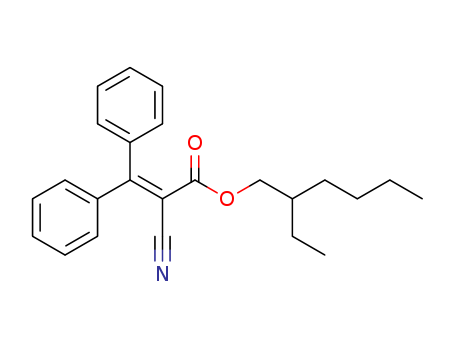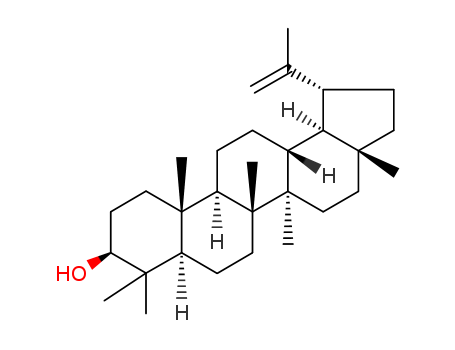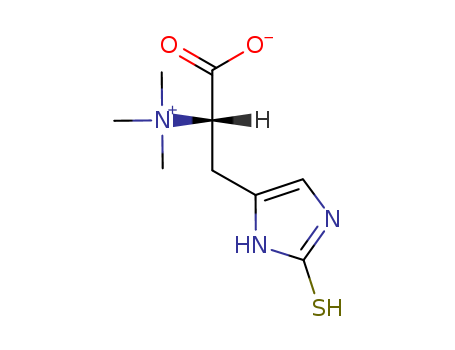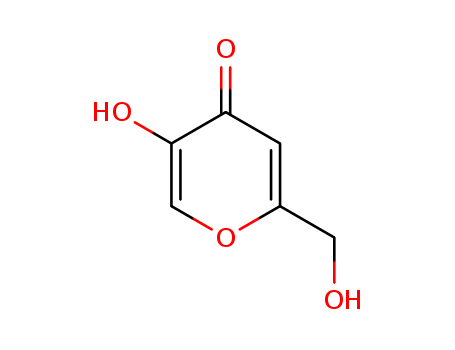
501-30-4
- Product Name:Kojic Acid
- Molecular Formula:C6H6O4
- Purity:99%
- Molecular Weight:142.111
Product Details
pd_meltingpoint:152-155 °C
Appearance:Tan powder
High-end Kojic Acid 501-30-4 top sale around the world
- Molecular Formula:C6H6O4
- Molecular Weight:142.111
- Appearance/Colour:Tan powder
- Melting Point:152-155 °C
- Refractive Index:1.4434 (estimate)
- Boiling Point:401.7 °C at 760 mmHg
- PKA:7.9(at 25℃)
- Flash Point:179.9 °C
- PSA:70.67000
- Density:1.542 g/cm3
- LogP:-0.16230
Kojic acid(Cas 501-30-4) Usage
|
Organic acids |
Kojic acid is composed of glucose by Aspergillus Candida in 30~32 ℃ under aerobic fermentation, having the antibacterial effect of organic acid, molecular structure is for substituted gamma pyrone, in naturally occurring γ-pyranone compounds, well-known compounds are only kojic acid and maltol. In 1907, Saito is by Aspergillus isolated kojic acid crystals. In 1912, it was named by Yabuta and in 1924 to determine the structure of kojic acid. In 1953, Arnstela (surface fermentation) and in1971 Kitada Makio (submerged fermentation) using isotope tracing technique converted that kojic acid is glucose without carbon frame fracture direct oxidation and dehydration to form. Kojic acid is present in the song, it is what people eat, safe use. In recent years, application of a large number of patent documentation report kojic acid was used in cosmetics. Tyrosinase is a key enzyme in melanin formation. Kojic acid can combine with tyrosinase copper chelate and make the loss of activity, which is the whitening effect.Clinical application and experimental results show that kojic acid can generate strong inhibitory effect on human skin melanin, safe and non-toxic, will not be caused sequelae of leukoplakia. Better combination of kojic acid and other agents (such as superoxide dismutase (SOD), placenta extract, amino acids, sunscreen agents and various kinds of plant extracts, etc.). Kojic acid is mainly used for skin whitening products, anti-aging products, sunscreen products, whitening facial cleanser and cosmetics. Kojic acid has certain antibacterial activity. Gram negative bacteria of kojic acid sodium of sensitive degree is greater than gram positive bacteria, while most other contrary in the antimicrobial substances. Inhibitory effect of kojic acid is far below other antibacterial substances and its antibacterial activity is bacteriostatic rather than sterilization. Kojic acid on yeast, virus and phage is invalid. The above information is edited by the lookchem Han Ya. |
|
Physicochemical properties |
Kojic acid crystal is prism shape, acicular, colorless. Kojic acid is soluble in water, alcohol, acetone, slightly soluble in ether, ethyl acetate, chloroform and pyridine, insoluble in most other solvent. Crystallization can be in acetone, ethyl acetate solvent , also be in the 150 to 200℃ by vacuum sublimation. The melting point of the reported in the literature is 151 to 154 ℃. 5,7-diethyl kojic acid and its derivatives respectively at 315 nm and 255nm have specific absorption peaks. Kojic acid is unstable to light and heat, the concentration 0.5% solution of kojic acid at different pH at a temperature of 100℃ treatment for 3h or sun light shined for 5h. The results at pH 5~7 solution become yellow to tan, but did not change much at pH4. Effect of kojic acid and ferric chloride is special red, this method can be used for kojic acid quantitative. Kojic acid can be reduced fee Lin reagent and ammoniacal silver nitrate and its molecular structure near the carbonyl has a hydroxyl group, and a variety of metal to form a salt and other hydroxyl can generate ether and ester derivatives. |
|
Food additives |
Kojic acid may be developed as a new food additive. As a food preservative sorbic acid is more than the performance of the ideal. Kojic acid can be used for fresh vegetables, fruits, fresh seafood, such as the cut apple, bananas, potatoes, mushrooms in 0.1% kojic acid solution leaching for 1 hour, can effectively prevent browning. Crab meat and shrimp and other seafood with 0.25%~0.6% kojic acid and 0.1% sodium sulfite solution respectively spray or infiltration method to treat Lentinus edodes, perishable vegetables such as spinach, results at room temperature for 1 day the alteration of mushroom and spinach 4 days later still keeps fresh, rarely atrophy. The dip of cut rose, rose, and so in 0.1% kojic acid solution at room temperature can be fresh for 8 days long. Kojic acid as an antioxidant can prevent oil deterioration and prevent the browning of dough. Combining with Ascorbic acid effect is better. Kojic acid can replace part of sodium nitrite in color hair color, and can inhibit the conversion of nitrite to carcinogenic nitrosamines. Studies suggest that the preservation mechanism of kojic acid inhibition of polyphenol oxidase in plants and animal carapace (i.e. tyrosinase). As mentioned above, kojic acid of antibacterial, antisepsis, fresh-keeping, color protection hair color, antioxidant effect in a body is a potential and the superior performance of food additives. |
|
Add whitening whitening cosmetics and kojic acid in food |
Kojic acid is a tyrosinase inhibitor, preemptive combined with tyrosinase copper ions, making the copper ions lose effect, can inhibit the synthesis of dopachrome. Kojic acid can inhibit 5,6-two hydroxy indole (DHI) polymerization, inhibition of DHICA oxidase activity. Addition of kojic acid in cosmetics can have skin care, moisturizing, whitening, bright, sunscreen, freckle function. Forms have cream, lotion, emulsion, soft membrane powder, clay, powder and so on. The earliest (1987) domestic developed and obtained the approval of the Ministry of health of the symbol (1991) is Nanjing Shi Shan Tou pharmaceutical factory 142-kojic acid freckle cream, kojic acid content is 1.5%, 2.0% in two sizes. Mainly used for pigmentation, chloasma, pregnancy spots, coffee spot), secondary pigment siderosis and melanosis, on chloasma total efficiency above 85% in the treatment of a variety of colors. Three Ming Feng reports containing 1% or 2.5% of kojic acid cream is used for chloasma, sunshine and senile spots, inflammation that leads to pigment accumulation and patients with freckles, paint for two months, on 204 cases of statistical results is: effective symptom is alleviated) more than 93 cases (accounted for 45.6%); slightly effective (symptoms relieved slightly) more than 151 cases (74%); kojic acid dosage 1% and 2.5% difference. Kojic acid, when heated and in the light, is easy to be yellowing, thus affecting the shelf life of kojic acid in cosmetics. Cryopreservation, adding ascorbic acid and hydroxyl methoxy phenyl ketone (2-hydroxy-4-dimethoxy diphenyl ketone) etc. shading agent can enhance its stability. |
|
Pest control and crop yield |
Kojic acid and divalent heavy metal complexes is better in the control effect of several kinds of plant fungi disease than Bordeaux mixture (a kind of insecticidal and fungicidal agent). The kojic acid complex is easy to prepare, spraying on the leaf adhesion is tightly without damage to the plants. These metals group in a non from form and kojic acid links, so toxic to humans is very low, safer than Bordeaux. Kojic acid or nicotinic insecticides activator, when dealing with wild melon silk moth (Diaphania hyalinata L.) and (Prodenia eridania cram.), with 5% nicotine sulfate pyrophyllite powder or 5% nicotine bentonite spraying agent adding 5% kojic acid and its toxicity were increased by 35% and 50%, separately. Kojic acid can also be used alone as a pesticide. Its mechanism is: in the coexistence and insect individual, impact on pest reproduction, disturb the hormone system, then the full eradication of the pest. Unlike conventional insecticides, not only to kill all the pests and the people, are harmless to humans and animals, and does not pollute the environment. Nickell and Gordon, 1963) has recommended a kojic acid as plant growth stimulant. From recent years patent, kojic acid as the crop yield, increasing agent is a promising. The method is to use kojic acid or its salt spray crop leaves or invasive roots, seeds, promoting crop root, stem and leaf growth and Promoting Blossom and bear fruit, improving the yield and quality. For example: 0.01~1000mg/L kojic acid solution spraying sweet potato seedlings after planting and harvest of sweet potato starch content increased by 10%~20%, the total yield increased by 20%~30%; from flowering to harvest, in foliar spraying concentration is 100mg/L of kojic acid solution of 8 times, tomato maturity, the sugar, the individual weight were significantly increased. China is the largest producer of hybrid rice, the hybrid rice seeds need to use "920". Considering the kojic acid production, cost advantages, it might make a difference on rice, corn, wheat, and so on of main grain crops production. |
|
Microbial fermentation of kojic acid |
Microbial fermentation of kojic acid refers to the process and technology of mass production of kojic acid by microbial fermentation method. Kojic acid is an acidic metabolites produced by Aspergillus oryzae and other microorganisms, soluble in water, ethanol or acetate. Most microorganisms can produce kojic acid for fungi, such as Aspergillus niger (Aspergillus oryzae), A.flavo-oryzae (Beige), Aspergillus flavus, Aspergillus candidus (A.flavus) (A.candidus) (A. clavatus), Aspergillus clavatus, huge Aspergillus (A.giganteus), Aspergillus fumigatus (A.fumigatus), a.tamarii (A.tamarii), Aspergillus WENTII (A.wentii) and a.glaucus (A.glaucus). Some bacteria such as rose Gluconobacter (Gluconobacter roseus), waxy Gluconobacter (G.cerinus) and Pseudomonas aeruginosa (Pseudomonas spp) can also use sugar to produce kojic acid. The basic fermentation process: Sweet potato powder by α-amylase hydrolysis→sterilizing→in the fermentation tank cooling→inoculation of Aspergillus oryzae seed from seed tank)→32 ℃and aerobic fermentation (about 5 days)→fermentation liquid filtration→ kojic acid zinc salt→decompression concentrating→crystallizing→acidification→kojic acid. kojic acid is used for manufacturing of food and daily necessities increase flavor enhancer maltol and ethyl maltol raw materials, but also the production of insecticide, fungicide and a film of dust removal agent of raw materials, and if some aliphatic carboxylic acid occurred acylation, kojic acid ester is obtained, it is raw material for manufacture of whitening cosmetics. Reference: Zhou Deqing, Xu Shiju. Dictionary of microbiology. Tianjin: Tianjin science and Technology Press.2005. |
|
Application and use |
Used in cosmetics, food additives, pharmaceutical etc,Used for quantitative analysis of ferric iron reagent. 1.kojic acid is widely used in food production. In the pas, because of oxidation resistance, it has been used for kojic acid grease to prevent rancidity. Recent reports, kojic acid has sterilization and insect resistance, as food preservatives, preservatives, color protection agent has obvious effect, can replace chemical preservatives, which is widely used in meat dish processing color, fresh fruits and vegetables, antiseptic raw food, but also can be used as cut flowers preservation and conservation agent to extend shelf life. Kojic acid is added in the food, do not influence the taste, aroma and texture and hinder the conversion of nitrite in paired human carcinogenic nitrosamines, which hinder or inhibition of cured meat products upgrading has a very important significance. Agricultural production, kojic acid can be used as biological pesticide, used as an insecticide, and can be used as bio fertilizer, regardless of the spraying or root application, the yield of grain and vegetables income effect is remarkable. 2. as a food flavoring agent of maltol and ethyl maltol raw materials. 3.kojic acid can be used to produce cephalosporin antibiotic raw materials. 4.In addition that kojic acid is widely used in food processing, but also has good freckle, whitening beauty effect. Kojic acid and its derivatives such as acetate has certain antibacterial and on the skin without a one-time stimulus and cumulative irritation, can be used as a preservative in cosmetics and food. Can strongly absorb ultraviolet light, used lonely or compatibility with all kinds of sunscreen products such as soap and so on. Treatment and prevention and treatment of skin pigmentation such as the formation of chloasma, dosage of 1~2.5% effect is obvious. It helps to keep moisture, reduce skin wrinkles. In activities ,it can be with dandruff remover. 5. It can be used for seasoning and manufacturing raw materials of kojic acid and ethyl maltol leaves skin pigment. |
|
Application prospect |
Kojic acid which is in food, cosmetics, medicine and other aspects for the efficient application, determines its considerable economic value and great potential for development. For industrialized production of kojic acid, Japan has occupied a leading position, but with the development of society, the progress of science and technology, all the countries in the world in terms of kojic acid production have been corresponding development. These provide a broad space for the development of domestic kojic acid industry . In short, kojic acid faces new opportunities and challenges as a new food additives in 21st century . Kojic acid is as a new type of preservative and will play an important role in food, cosmetic and pharmaceutical industry . |
|
Extraction and purification of kojic acid |
Kojic acid with divalent metal ions can form insoluble metal chelates, and this property can be utilized in the extraction. Secondly, kojic acid is soluble in water but little solubility, temperature on the solubility of great influence, is conducive to the concentration cooling crystallization. Kojic acid can be as iron reagent. Even with the use of fermented in stainless steel tanks, the fermentation broth was also red brown, this nature influences to extraction and refining process. Kojic acid was extracted from the fermentation broth by the copper salt precipitation, ethyl acetate extraction, ether by continuous extraction, concentration and crystallization or freezing crystallization. In 20th century 70s, the Beijing daily chemical factory used zinc salt method. |
|
The safety of kojic acid |
Japanese scholars in traditional fermented products of kojic acid to illustrate the kojic acid as the safety of food additives, which can be not limited to add. Because kojic acid has certain antibacterial and antioxidation, in Japan kojic acid has been widely used in food processing of color protection and transportation of fruits and vegetables, fresh aquatic products, medical anti-inflammatory agent and so on. The Japanese government early in April 1988 approved in cosmetics to add kojic acid as a sunscreen, Xiaoban, white beautiful new pharmaceuticals. China's Ministry of health approved the first Nanjing Shi Shan Tou pharmaceutical factory production of 142-kojic acid cream cosmetics for special purposes in 1991. In August of 1992, Shanghai Normal University Science and Technology Development Co., Ltd. production of kojic acid as additive in cosmetics by the Shanghai chemical toxicity assessment. Reference: Wang Boyan, Jin Qirong. Production and application of fermentation acid. Beijing: Chinese Light Industry Press.2007. |
|
Biochem/physiol Actions |
Kojic acid is derived from some fungal species such as, Aspergillus, Acetobacter and Penicillium.. It halts melanin synthesis by inhibiting tyrosinase enzyme. It is used in the preparation of skin whitening cosmetics. However, kojic acid usage is minimal in cosmetics, as it induces skin irritation by its unstability and cytotoxic nature during long storage. It is an antioxidant and elicits radioprotective effects on chelating with manganese and zinc. |
|
Purification Methods |
Crystallise the acid from MeOH (charcoal) by adding Et2O. It sublimes at 150-200o/0.1torr. [Beilstein 18 II 57, 18 III/IV 1145, 18/2 V 516.] |
|
Chemical Composition and Structure |
Kojic acid (KA) is a natural metabolite produced by fungi. Chemically, it is identified as 5-hydroxymethyl-pyrone. Its structure includes a hydroxymethyl group attached to a pyrone ring. |
|
Sources |
Kojic acid is commonly produced by various species of fungi such as Aspergillus, Acetobacter, and Penicillium. It is also formed during the fermentation of foods like soy sauce, miso, and sake. |
|
History and Development |
Kojic acid was first marketed in 1955 by Charles Pfizer and Company, USA. Since then, its production has increased due to its commercial value in various industries. However, its carcinogenic potential led to its classification as a Class 3 carcinogen by the World Health Organization. |
|
Production Methods |
Kojic acid is industrially produced by Aspergillus species in aerobic fermentation. Various carbon sources such as glucose, sucrose, and ethanol are utilized for its production. |
|
Definition |
ChEBI: A pyranone that is 4H-pyran substituted by a hydroxy group at position 5, a hydroxymethyl group at position 2 and an oxo group at position 4. It has been isolated from the fungus Aspergillus oryzae. |
|
General Description |
Kojic acid, a tyrosinase inhibitor, is produced by several fungi species, including Aspergillus oryzae. It exhibits skin-lightening property, due to its ability to chelate the copper-containing enzyme tyrosinase in the formation of melanin. Kojic acid is also commonly used as a whitening agent in regular cosmetics, bleaching cosmetics, etc. It is found to be a therapeutic agent and helps in preventing pigmentation. |
InChI:InChI=1/C6H6O4/c7-2-4-1-5(8)6(9)3-10-4/h1,3,7,9H,2H2
501-30-4 Relevant articles
Adamantyl pyran-4-one derivatives and their in vitro antiproliferative activity
Perokovi?, Vesna Petrovi?,Car, ?eljka,Usenik, Andrea,Opa?ak-Bernardi, Teuta,Juri?, Andrea,Tomi?, Sr?anka
, p. 253 - 263 (2019/04/25)
Abstract: Pyran-4-one (maltol, kojic aci...
Chemo-enzymatic three-step conversion of glucose to kojic acid
Lassfolk, Robert,Suonpa?, Anu,Birikh, Klara,Leino, Reko
supporting information, p. 14737 - 14740 (2019/12/23)
Kojic acid is an important biomolecule, ...
Facile reduction of carboxylic acids to primary alcohols under catalyst-free and solvent-free conditions
Harinath, Adimulam,Bhattacharjee, Jayeeta,Panda, Tarun K.
supporting information, p. 1386 - 1389 (2019/02/05)
We report the development of a facile pr...
Re-examination of nucleophilic substitution in chlorokojic acid
Uher, Michal,Szymońska, Joanna,Korenova, Anna,Tomasik, Piotr
, p. 301 - 307 (2007/10/03)
Chlorokojic acid was reacted with S2O23 ...
501-30-4 Process route
-
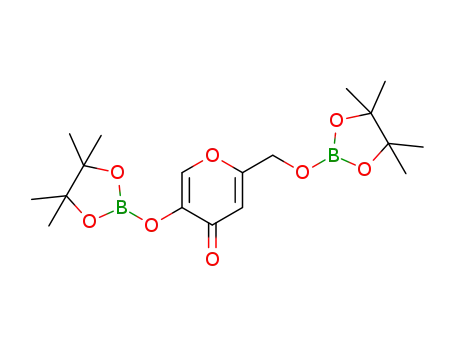
-
5-((4,4,5,5-tetramethyl-1,3,2-dioxaborolan-2-yl)oxy)-2-(((4,4,5,5-tetramethyl-1,3,2-dioxaborolan-2-yl)oxy)methyl)-4H-pyran-4-one

-
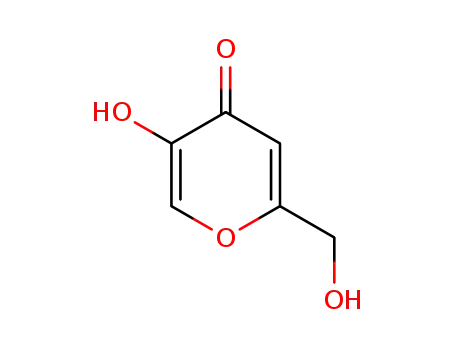
- 501-30-4,123712-78-7
5-hydroxy-2-(hydroxymethyl)-4H-pyran-4-one
| Conditions | Yield |
|---|---|
|
With silica gel; In methanol; at 60 ℃; for 3h; Inert atmosphere;
|
70% |
-
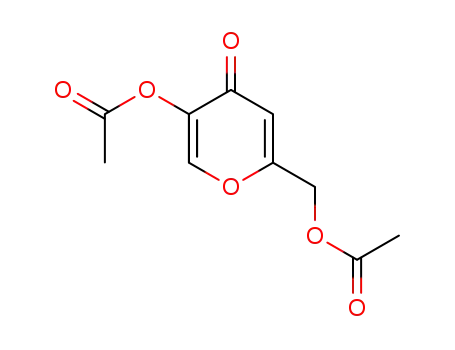
- 26209-93-8
5-acetoxy-2-acetoxymethyl-4H-pyran-4-one

-

- 501-30-4,123712-78-7
5-hydroxy-2-(hydroxymethyl)-4H-pyran-4-one
| Conditions | Yield |
|---|---|
|
With sodium methylate; In methanol; for 1h;
|
95% |
|
With methanol; ammonia;
|
501-30-4 Upstream products
-
58-86-6
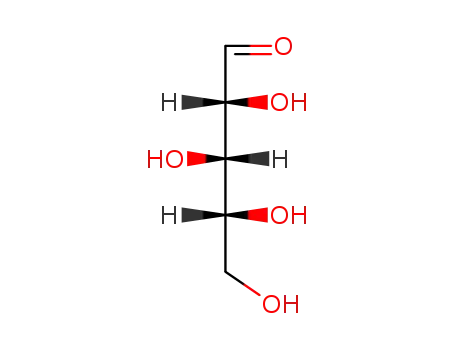
D-xylose
-
69-65-8
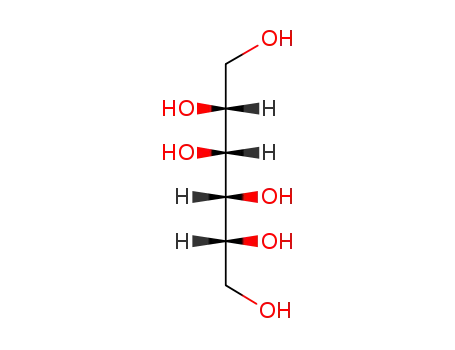
mannitol
-
50-70-4
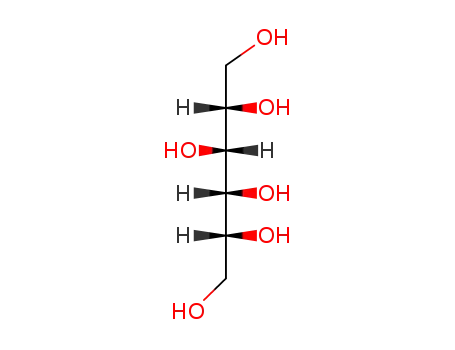
D-sorbitol
-
608-66-2
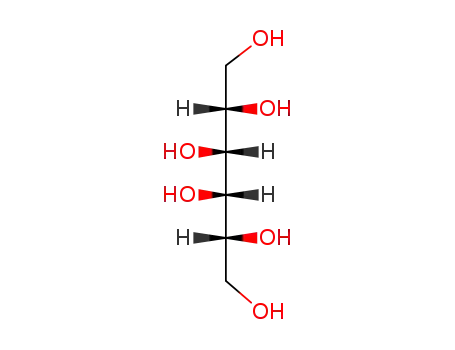
D-galactitol
501-30-4 Downstream products
-
6269-25-6
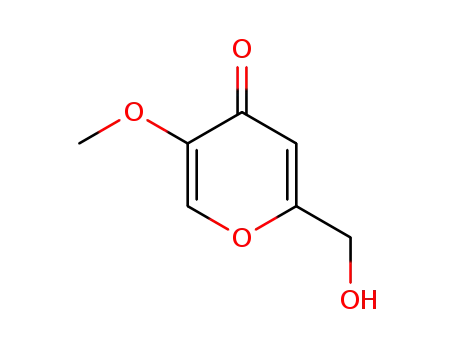
2-Hydroxymethyl-5-methoxy-4H-pyran-4-on
-
103649-94-1
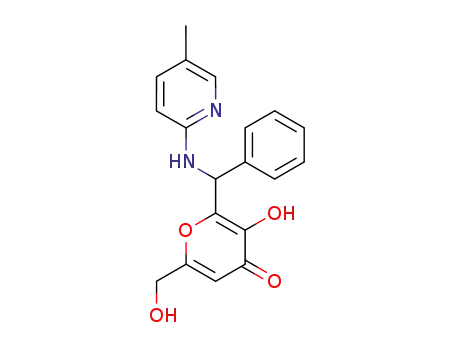
3-hydroxy-6-hydroxymethyl-2-[α-(5-methyl-[2]pyridylamino)-benzyl]-pyran-4-one
-
2029-49-4
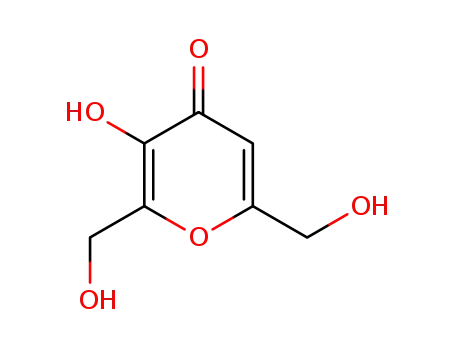
2,6-dihydroxymethyl-3-hydroxy-4-pyrone
-
873969-44-9
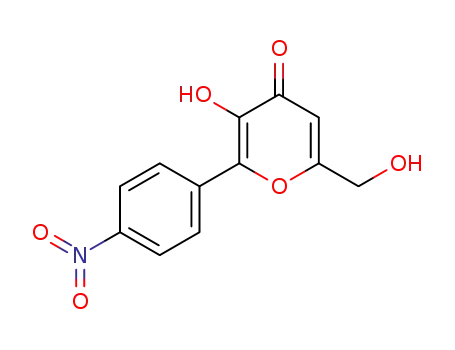
3-hydroxy-6-hydroxymethyl-2-(4-nitro-phenyl)-pyran-4-one
Relevant Products
-
0ctocrylene
CAS:6197-30-4
-
Lupeol
CAS:545-47-1
-
Ergothioneine
CAS:497-30-3

